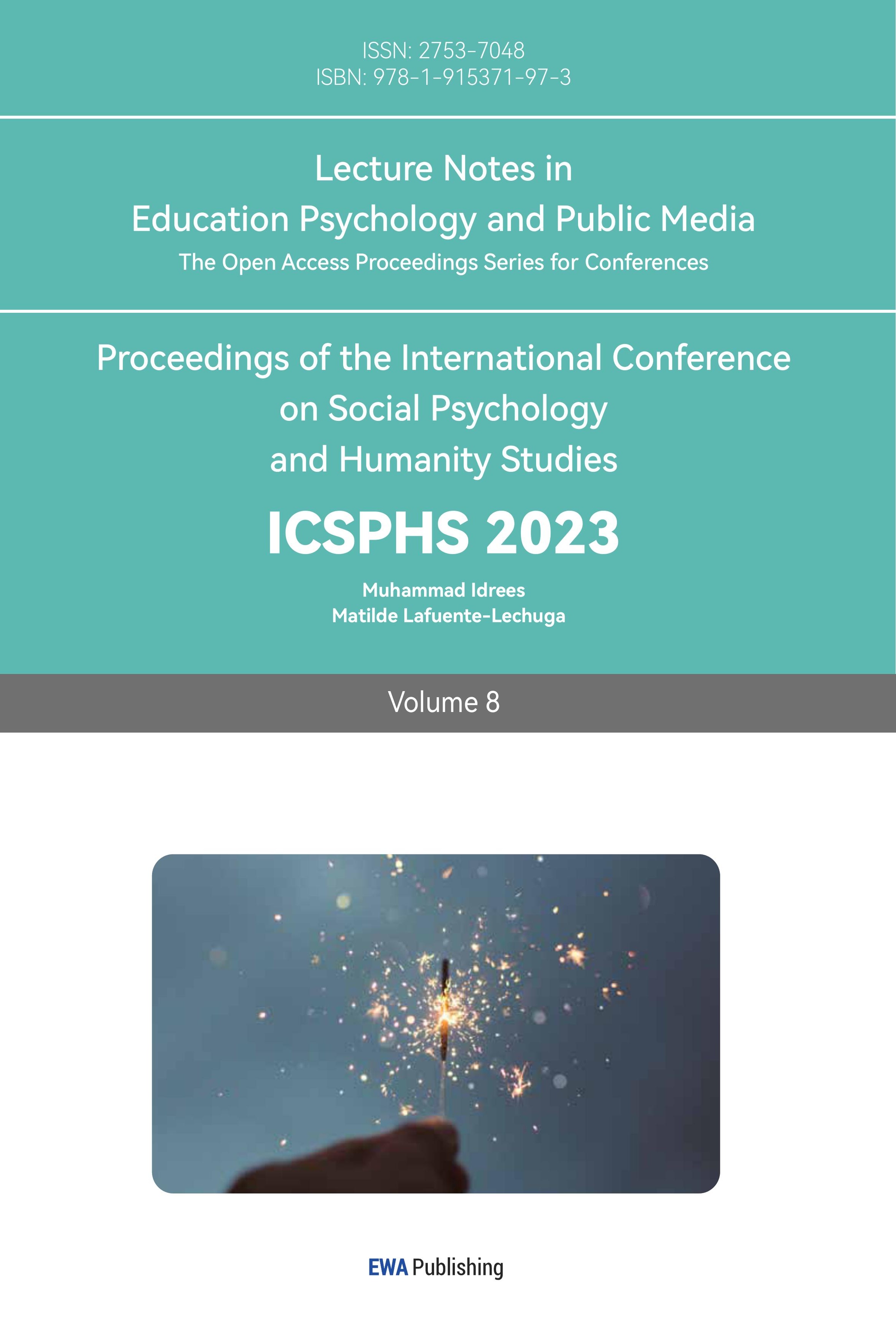References
[1]. Zhang Ying. Liang Qichao's Record of the Prohibition of Chinese Workers [J]. Historical Research, 1984 (4):69.
[2]. Zhang Qingsong. Inside Stories of America's Hundred Years of Exclusion from China [M]. Shanghai: Shanghai People's Publishing House,1998.
[3]. Huang Zhihu. The Rise and Fall of the US China Exclusion Act and Sino US Diplomatic Relations [J]World Economic and Political Forum, 2013 (3): 9.
[4]. Cao Qian. The Anti-Chinese Policy of the United States in the Late Qing Dynasty and the Attitude of the Qing Government [J]. Overseas Chinese Historical Studies, 1986 (4).
[5]. Yuan Peng, Lin Yan. On the Origin of the US Policy of Excluding China [J]. Research on Foreign Issues,1996 (3).
[6]. Chen Xiaoyan. Analysis of the root causes of the exclusion of China in modern America [J]. Journal of Hangzhou University,1998 (3): 68.
[7]. Song Li Ruifang. History and Current Situation of Chinese Americans [M]. Beijing: Business Press Museum, 1984: 43 – 54.
[8]. Chen Yifan. History of Chinese Americans [M]. Beijing: World Knowledge Press, 1987.
[9]. Nayan Shah. Contagious Divides,2001:1-16.
[10]. Mink, G. (2019). Old labor and new immigrants in American political development: union, party, and state, 1875-1920. Cornell University Press.
[11]. Erika Lee. The Making of Asian America, 2015 (4):112-115.
[12]. WELLBORN, M. (1912). THE EVENTS LEADING TO THE CHINESE EXCLUSION ACTS. Annual Publication of the Historical Society of Southern California, 9(1/2), 49–58. https://doi.org/10.2307/41168895
[13]. Sang Hea Kil (2012) Fearing yellow, imagining white: media analysis of the Chinese Exclusion Act of 1882, Social Identities, 18:6, 663-677, DOI: 10.1080/13504630.2012.708995.
[14]. Lee, E. (2015). The making of Asian America: A history. Simon and Schuster.
[15]. Miller, S. C. (1969). The unwelcome immigrant: The American image of the Chinese, 1785-1882. University of California Press.
[16]. Gyory, A. (1998). Closing the gate: Race, politics, and the Chinese Exclusion Act. Univ of North Carolina Press.
Cite this article
Sun,Y.;Shen,J.;Guo,J.;Jing,S.;Yang,X. (2023). Changes in the Treatment of Chinese Americans. Lecture Notes in Education Psychology and Public Media,8,410-416.
Data availability
The datasets used and/or analyzed during the current study will be available from the authors upon reasonable request.
Disclaimer/Publisher's Note
The statements, opinions and data contained in all publications are solely those of the individual author(s) and contributor(s) and not of EWA Publishing and/or the editor(s). EWA Publishing and/or the editor(s) disclaim responsibility for any injury to people or property resulting from any ideas, methods, instructions or products referred to in the content.
About volume
Volume title: Proceedings of the International Conference on Social Psychology and Humanity Studies
© 2024 by the author(s). Licensee EWA Publishing, Oxford, UK. This article is an open access article distributed under the terms and
conditions of the Creative Commons Attribution (CC BY) license. Authors who
publish this series agree to the following terms:
1. Authors retain copyright and grant the series right of first publication with the work simultaneously licensed under a Creative Commons
Attribution License that allows others to share the work with an acknowledgment of the work's authorship and initial publication in this
series.
2. Authors are able to enter into separate, additional contractual arrangements for the non-exclusive distribution of the series's published
version of the work (e.g., post it to an institutional repository or publish it in a book), with an acknowledgment of its initial
publication in this series.
3. Authors are permitted and encouraged to post their work online (e.g., in institutional repositories or on their website) prior to and
during the submission process, as it can lead to productive exchanges, as well as earlier and greater citation of published work (See
Open access policy for details).
References
[1]. Zhang Ying. Liang Qichao's Record of the Prohibition of Chinese Workers [J]. Historical Research, 1984 (4):69.
[2]. Zhang Qingsong. Inside Stories of America's Hundred Years of Exclusion from China [M]. Shanghai: Shanghai People's Publishing House,1998.
[3]. Huang Zhihu. The Rise and Fall of the US China Exclusion Act and Sino US Diplomatic Relations [J]World Economic and Political Forum, 2013 (3): 9.
[4]. Cao Qian. The Anti-Chinese Policy of the United States in the Late Qing Dynasty and the Attitude of the Qing Government [J]. Overseas Chinese Historical Studies, 1986 (4).
[5]. Yuan Peng, Lin Yan. On the Origin of the US Policy of Excluding China [J]. Research on Foreign Issues,1996 (3).
[6]. Chen Xiaoyan. Analysis of the root causes of the exclusion of China in modern America [J]. Journal of Hangzhou University,1998 (3): 68.
[7]. Song Li Ruifang. History and Current Situation of Chinese Americans [M]. Beijing: Business Press Museum, 1984: 43 – 54.
[8]. Chen Yifan. History of Chinese Americans [M]. Beijing: World Knowledge Press, 1987.
[9]. Nayan Shah. Contagious Divides,2001:1-16.
[10]. Mink, G. (2019). Old labor and new immigrants in American political development: union, party, and state, 1875-1920. Cornell University Press.
[11]. Erika Lee. The Making of Asian America, 2015 (4):112-115.
[12]. WELLBORN, M. (1912). THE EVENTS LEADING TO THE CHINESE EXCLUSION ACTS. Annual Publication of the Historical Society of Southern California, 9(1/2), 49–58. https://doi.org/10.2307/41168895
[13]. Sang Hea Kil (2012) Fearing yellow, imagining white: media analysis of the Chinese Exclusion Act of 1882, Social Identities, 18:6, 663-677, DOI: 10.1080/13504630.2012.708995.
[14]. Lee, E. (2015). The making of Asian America: A history. Simon and Schuster.
[15]. Miller, S. C. (1969). The unwelcome immigrant: The American image of the Chinese, 1785-1882. University of California Press.
[16]. Gyory, A. (1998). Closing the gate: Race, politics, and the Chinese Exclusion Act. Univ of North Carolina Press.









